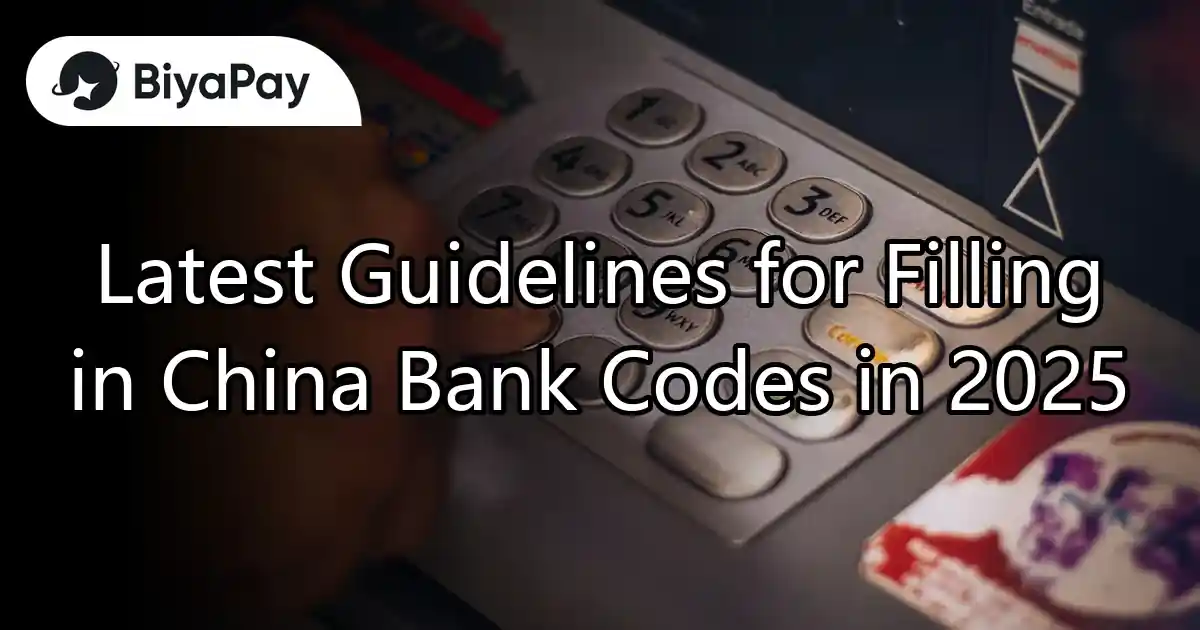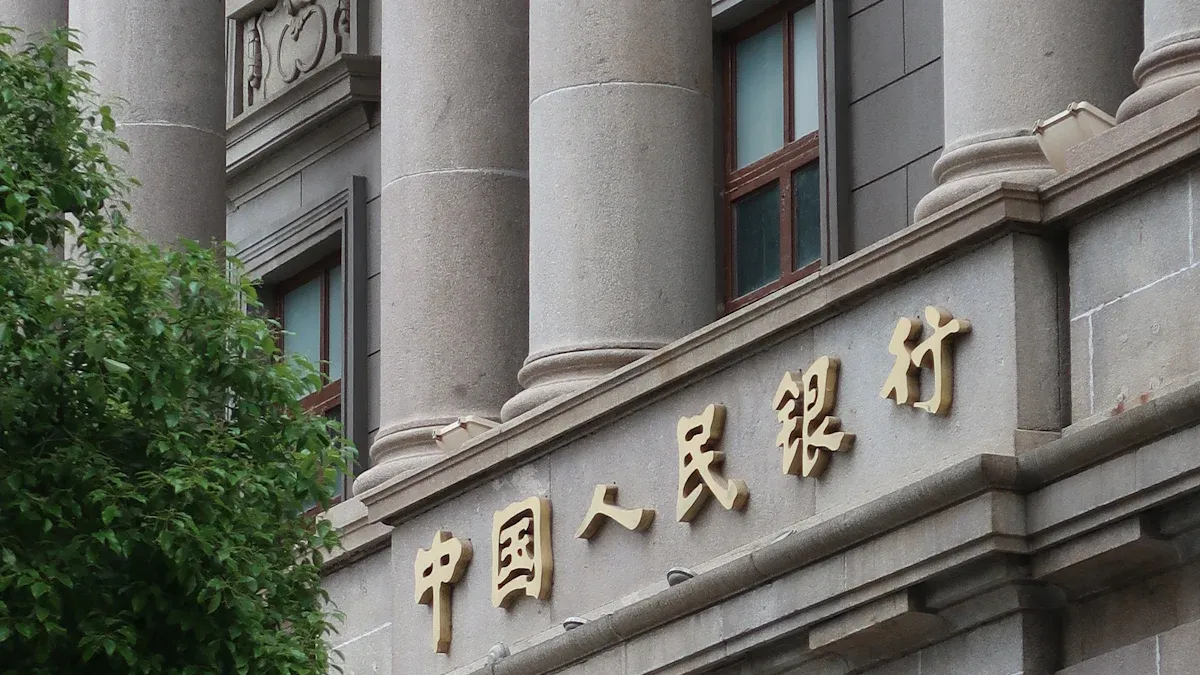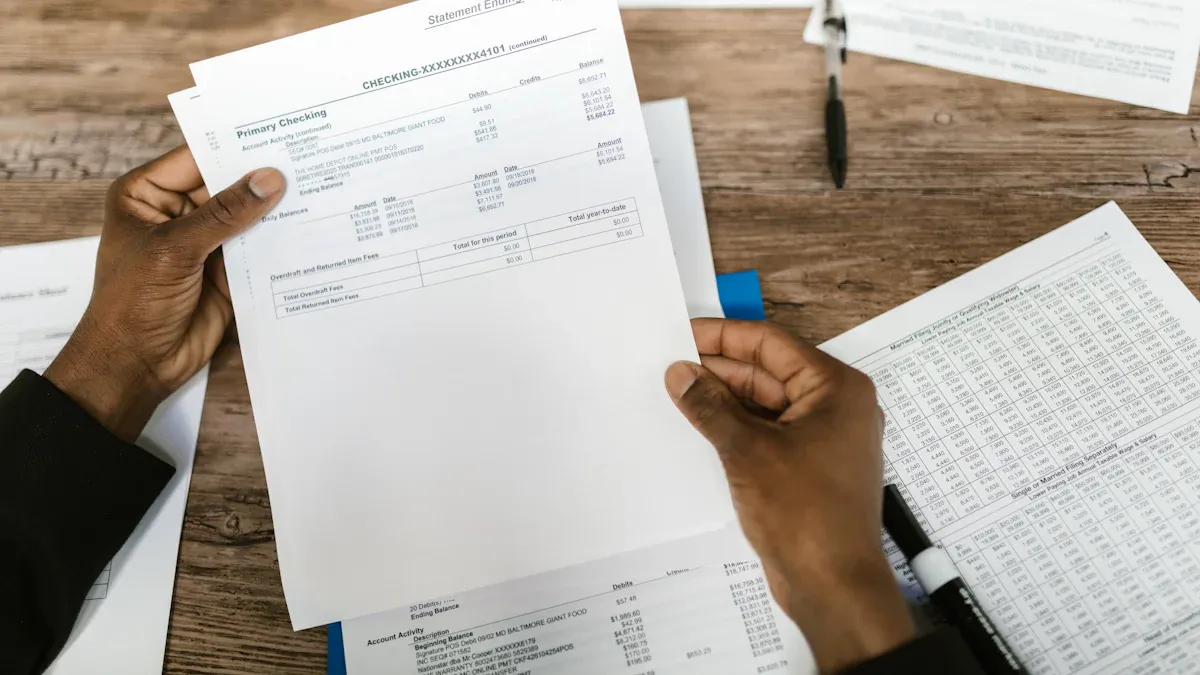- EasyCard
- Trade
- Help
- Announcement
- Academy
- SWIFT Code
- Iban Number
- Referral
- Customer Service
- Blog
- Creator
Latest Guidelines for Filling in China Bank Codes in 2025

Image Source: unsplash
You may wonder if there are any new changes to China bank codes in 2025. Based on current information, there are no significant updates to the bank code rules. You must ensure the data is correct when filling in the bank code. Errors in the bank code can affect fund security and even lead to transfer failures. You should carefully verify each digit to ensure the transfer is completed smoothly.
Key Points
- In 2025, there are no major changes to China bank code rules, and you can continue using the existing format for filling.
- The bank code consists of three parts: bank code, branch code, and account number, which must be verified individually to ensure accuracy.
- When filling in, use only numbers and English letters, avoiding spaces, Chinese characters, or symbols to ensure a continuous and correct format.
- Different platforms have varying requirements; FPS (Faster Payment System) requires only the account number, while cross-border transfers require an additional SWIFT Code.
- Incorrect bank codes can lead to transfer failures or delays, so carefully verify data and contact the bank promptly for corrections.
Latest Regulations for China Bank Codes

Image Source: pexels
Any Changes in 2025?
You may be concerned about whether there will be new rules for China bank codes in 2025. According to the latest official information, there are no significant changes to the regulations for China bank codes in 2025. You can continue using the existing code format to handle daily transfers and remittances. Banks and financial institutions will verify your data based on current standards. As long as you ensure the data is correct, you can safely complete fund transfers.
Tip: You should regularly check announcements from banks or financial platforms. If there are new policies or minor adjustments, banks will notify you promptly.
Code Composition and Format
China bank codes generally consist of three parts. You need to understand the meaning of each part to fill them in correctly.
- Bank Code (3 digits)
This is a unique number used to identify the bank. Each bank has its own code. - Branch Code (3 digits)
This part represents the branch you are associated with. Different branches have different branch codes. - Account Number (7 to 9 digits)
This is your personal bank account number. The number of digits in account numbers may vary across banks.
You can refer to the table below to understand the bank codes of common Hong Kong banks:
| Bank Name | Bank Code |
|---|---|
| HSBC | 004 |
| Hang Seng Bank | 024 |
| Bank of China (Hong Kong) | 012 |
| Standard Chartered Bank | 003 |
| Bank of East Asia | 015 |
When filling in the China bank code, you must enter all digits according to the correct format provided by the bank. You should avoid using Chinese characters or other symbols and use only numbers and English letters (if required). If you are making a cross-border transfer, you will also need to fill in the SWIFT Code. You can inquire with the bank for the correct SWIFT Code and related information.
Note: The number of digits in account numbers may vary across banks. You should carefully verify the information provided by the bank to ensure every digit is correct.
Precautions for Filling in Bank Codes
Key Points for Data Verification
When filling in the China bank code, you must first verify all data. You need to ensure the bank name, branch name, and account number are all correct. You can refer to the bank’s monthly statement or online banking information. You should not rely solely on verbal information, as a small error could lead to a failed fund transfer.
- You should check the following points:
- Whether the bank name is correct (e.g., HSBC, Hang Seng Bank, Bank of China (Hong Kong), etc.)
- Whether the branch name and branch code are correct
- Whether every digit of the account number is correct
- Whether the transfer amount (in USD) is correct, and note the exchange rate of the day
Tip: You can write down the bank details on paper and cross-check them to reduce the chance of errors.
Format and Digit Requirements
When filling in the China bank code, you must use the correct format. You can only enter numbers and English letters (if required) and should not include Chinese characters or other symbols. The number of digits in account numbers may vary across banks, and you should fill them in based on the information provided by the bank.
- Common formats are as follows:
Item Format Example Description Bank Code 012 3 digits Branch Code 123 3 digits Account Number 1234567 or 123456789 7 to 9 digits
You should not arbitrarily add spaces or punctuation marks. You should ensure all digits are entered consecutively. If you find that the account number’s digit count does not match, you should immediately contact the bank for clarification.
Note: Some banks require you to enter the full China bank code, including bank code, branch code, and account number, on online platforms. You should follow the platform’s instructions.
Filling on Different Platforms
When filling in the China bank code on different platforms, you may encounter varying requirements. You should follow the platform’s instructions to ensure the data is correct.
- Electronic Transfers (e.g., FPS)
When using FPS, you usually only need to enter the account number or mobile number. You should ensure the correct bank name is selected. If you need to enter the full China bank code, you must fill it in according to the platform’s instructions. - Cross-Border Transfers
For cross-border transfers, in addition to the China bank code, you need to fill in the SWIFT Code. For example, the SWIFT Code for Bank of China (Hong Kong) is “BKCHHKHH”. You should confirm the correct SWIFT Code and account details with the recipient. You also need to note exchange rate fluctuations, as the transfer amount will be calculated in USD based on the day’s exchange rate. - Online Banking or Mobile Apps
When entering the China bank code in online banking or mobile apps, you should follow the platform’s format requirements. You should not copy and paste, as this may include extra spaces or symbols. You should enter each digit manually and double-check.
Tip: You can first write down the China bank code on paper, then enter it according to the platform’s requirements to reduce errors.
Common Errors and Prevention

Image Source: pexels
Error Types
The most common errors when filling in the China bank code include:
- Entering the wrong bank code. For example, you mistakenly write HSBC’s code “004” as “003”.
- Errors in the branch code. Sometimes, you may confuse the branch code with the account number.
- Incorrect account number digits. Some bank account numbers have 7 digits, others 9. Missing or adding a digit will cause the transfer to fail.
- Illegible handwriting or corrections. When filling out forms by hand, unclear digits or corrections may prevent the bank from recognizing them.
- Extra spaces or symbols from copying and pasting. When entering in online banking, copied account numbers may include unwanted spaces.
Note: Before filling in, you should check the bank name and code to avoid confusion.
Verification Steps
You can follow these steps to reduce the chance of errors:
- Prepare your bank statement or official documents and verify all information.
- Follow the bank’s instructions to fill in the bank code, branch code, and account number separately.
- Check the account number’s digit count to ensure it matches the bank’s requirements.
- Use a numeric keypad to enter each digit individually, avoiding copy-paste to prevent extra spaces.
- Double-check all digits after filling, especially each part of the China bank code.
- If in doubt, immediately call the bank or check the official website.
| Verification Item | What You Should Do |
|---|---|
| Bank Code | Cross-check with official lists |
| Branch Code | Verify branch information |
| Account Number | Check digit count and accuracy |
| Filling Format | Use only numbers, no symbols |
Tip: You can ask family or friends to double-check to ensure the information is correct, significantly reducing the risk of transfer failures.
Consequences of Incorrect Bank Codes
Transfer Failures and Delays
If you fill in the wrong bank code, the most common consequence is a transfer failure. The bank system will reject your instructions due to mismatched data. You may find that funds do not arrive instantly or experience delays. In such cases, your funds may be temporarily frozen until the bank completes verification. If you transfer on a business day, the delay may be one to two days. However, during holidays or weekends, delays could be longer. You should also note that cross-border transfers involve USD and exchange rate fluctuations, and delays may result in losses due to rate differences.
Note: You must be especially careful when filling in bank details each time. Even a single incorrect digit cannot be automatically corrected by the bank.
Remedial Suggestions
If you discover an error in the bank code, you should take immediate action. You can follow these steps to address the issue:
- Immediately contact your bank or the financial platform used and explain the situation.
- Provide the correct bank details, including bank name, branch code, and account number.
- Check the current status of the funds to see if they have been returned or are still processing.
- For cross-border transfers, also verify the SWIFT Code and exchange rate situation.
- Keep all transaction and communication records for the bank’s follow-up.
By proactively contacting the bank, they will assist you in recovering the funds based on your situation. If you catch the error early, the bank can process it faster. You should regularly check your bank account to ensure every fund arrives correctly. You can also refer to the bank’s official website for the latest guidelines on filling in China bank codes.
Correctly filling in the bank code significantly enhances fund security and transfer success rates. Querying accurate information brings several benefits:
- Helps banks process forms correctly, improving operational efficiency
- Increases data accuracy by 50%
- Reduces bank phone inquiries by 30%
- Shortens time for manual financial statement entry
- System analysis can directly provide supplements for anomalies, reducing communication time
- Improves review efficiency, shortening processing time by 20%
You can check the correct bank code through the bank’s official website, online banking, or by calling customer service. If you have any doubts, you should promptly contact the bank or platform to ensure every transfer is safe and accurate.
FAQ
What is the difference between a bank code and an account number?
The bank code identifies the bank and branch. The account number is your personal bank account. You should distinguish them clearly when filling in to avoid confusion.
Can I use Chinese characters or symbols to fill in the bank code?
You cannot use Chinese characters or symbols. You must use only numbers and English letters (if required) to fill in the bank code for the bank to process correctly.
How can I check the bank code if I’m unsure?
You can check the bank’s official website or call customer service. The table below lists common Hong Kong bank codes:
| Bank Name | Bank Code |
|---|---|
| HSBC | 004 |
| Hang Seng Bank | 024 |
| Bank of China (Hong Kong) | 012 |
What currency should be used for the amount when filling in the bank code?
You should use USD for the amount. You need to note the exchange rate of the day, as the bank will convert based on the rate during the transfer.
What’s the difference between filling in bank codes for FPS and cross-border transfers?
For FPS, you usually only need to enter the account number or mobile number. For cross-border transfers, you need to fill in the SWIFT Code and bank code to ensure accuracy.
Accurate bank codes (e.g., Bank of China (Hong Kong) 012) and SWIFT codes (BKCHHKHH) ensure secure transfers, preventing failures or delays. BiyaPay offers a single platform for trading U.S. and Hong Kong stocks without needing overseas accounts—start now at BiyaPay! Its cross-border remittances, with fees as low as 0.5%, support USD/HKD conversions (1 USD ≈ 7.8 HKD) across 190+ countries, ensuring cost clarity.
Real-time exchange rates and an economic calendar help verify data for precise decisions. The 5.48% annualized yield wealth product offers flexible withdrawals. Regulated internationally, it guarantees security. Visit BiyaPay to streamline remittances and investments!
*This article is provided for general information purposes and does not constitute legal, tax or other professional advice from BiyaPay or its subsidiaries and its affiliates, and it is not intended as a substitute for obtaining advice from a financial advisor or any other professional.
We make no representations, warranties or warranties, express or implied, as to the accuracy, completeness or timeliness of the contents of this publication.




Contact Us
Company and Team
BiyaPay Products
Customer Services
is a broker-dealer registered with the U.S. Securities and Exchange Commission (SEC) (No.: 802-127417), member of the Financial Industry Regulatory Authority (FINRA) (CRD: 325027), member of the Securities Investor Protection Corporation (SIPC), and regulated by FINRA and SEC.
registered with the US Financial Crimes Enforcement Network (FinCEN), as a Money Services Business (MSB), registration number: 31000218637349, and regulated by FinCEN.
registered as Financial Service Provider (FSP number: FSP1007221) in New Zealand, and is a member of the Financial Dispute Resolution Scheme, a New Zealand independent dispute resolution service provider.



















